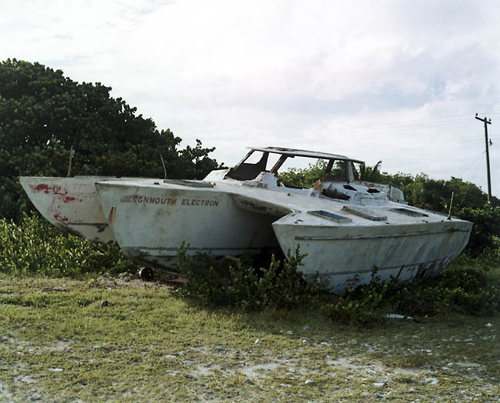Review of Tacita Dean’s Teignmouth Electron
Matthew Connors
The Highlights (March, 2008)
If history is a pact between the living and the dead, the self-destructive would be wise to strike an accord with Tacita Dean. Her slender and beautifully constructed book Teignmouth Electron reexamines the fateful voyage of Donald Crowhurst, an amateur sailor who disappeared at sea during the 1968 Golden Globe solo, nonstop, around-the-world yacht race. A victim of his own delusions and the politics of a provincial seaside village, he set out from Teignmouth, Devon, with scant experience and an unfit boat. When his abandoned vessel was found drifting in the mid-Atlantic eight months later, it was discovered that he never made it past the Cape of Good Hope. Fearful of entering the roaring forties, Crowhurst spent months meandering off the coast of Argentina. After a protracted radio silence, he began issuing false reports that exaggerated his progress. To much fanfare, the public believed him to be the race leader and on the verge of setting a new world record. His logbooks later revealed a mind anguished by overwhelming pressure to succeed and the inescapable deception he set in motion. Increasingly distressed, he withdrew to an internal world dominated by an obsession with time and abstract metaphysical speculations. He convinced himself he was floating through prehistory, and ultimately jumped overboard with his faulty chronometer. It is a remarkable story of a mind driven to despair by extreme isolation in an unyielding environment worthy of Herzogian investigation. Well-documented in numerous articles, a non-fiction book, and a recent documentary, the events have also been the basis of two fictional films and a novel. Dean’s book, though, takes a much more oblique approach to these events. She engages in an experiential investigation of the tangible artifacts and cultural memory of Crowhurst’s voyage, splicing herself into his sensational story of estrangement and self-destruction.
Like the hastily built trimaron from which its title is derived, Teignmouth Electron is a loose patchwork of disparate sources. It is the culmination of several years of Dean’s personal research and involvement, weaving together brief essays, photographs, travelogues, complex anecdotes, film analyses, accounts of dreams, and a correspondence with J.G. Ballard. Rooted in her various modes of engagement with the narrative, the book often follows unpredictable threads to find unexpected connections. It opens with the eerily resonant lyrics of Bowie’s Space Oddity — written in the same year that Crowhurst disappeared — and at times seems to get lost in a sea of associations, contemplating the echoes of past (Antoine de Saint-Exupéry), contemporaneous (Brian Jones), and subsequent (Bas Jan Ader) plights. What threads these elements together is not so much the potency of the tale itself, but her pursuit of the perceptible residues and tangential associations offered by objects and people connected to Crowhurst’s voyage.
In search of these residues, Dean set out on her own journeys to Teignmouth and, later, to Cayman Brac, where she photographed the book’s eponymous trimaron beached in its final resting place. She states, “When someone disappears at sea the boat is their last physical embodiment… I had to go… it was really important.” Traces of Crowhurst and his ordeal are palpable in these haunting photographs. They show a weather-beaten, sun-bleached vessel dissolving into the lush foliage of its tropical surroundings. Dean thoroughly documents the boat that has clearly been ravaged by the elements and looters. One photograph shows the remnants of rusted cans, other decayed provisions, and a cluster of unused flares she discovered in a secret hatch on the bottom of the boat’s hull. So great was Crowhurst’s fear of capsizing that he had these compartments custom-designed. Another shows the boat angled toward the nearby sea, a solitary palm tree obstructing its path.
Eschewing a wealth of original 16mm footage and photographs—much of which was shot by Crowhurst himself — the book adopts her poignant photographs of the Electron as its visual cynosure. The decrepit yacht is the closest tangible link to Crowhurst’s experiences and is at the center of Dean’s involvement. Aligned with the Barthian notion that photographs often supplant rather than supplement memory, Dean uses her images to bypass accepted accounts in an attempt to reinterpret the Crowhurst story. Her photographs, as well as the detailed account of the Electron’s subsequent history — from cursed Jamaican pleasure cruiser to abandoned restoration project — are documents of the narrative’s surviving documents. They form the epicenter around which she calibrates her sympathies.
Tacita Dean’s compassion for Crowhurst is pronounced. She hints at a solidarity, albeit grossly exaggerated, when recounting her troubles with the weather and airport timetables while obsessively photographing the Electron on its ‘claustrophobic’ island. Hers is a questionable rendition that repositions Crowhurst as a semi-heroic figure. It downplays that his demise was largely self-inflicted, brought on by his bravado and incompetence. From his initial descent into time-madness to his cryptic last log entry, “it is finished. it is finished. it is the mercy,” she sees him as a victim whose suicide was an atonement for his sin of concealment — a means of revealing himself. “If you ask anybody about Donald Crowhurst, they will talk, more often than not, about fraud and deceit, and about the man who faked his journey around the world. But the story of Donald Crowhurst is more about integrity than forgery. It is a story about truth.” However you judge Crowhurst’s role in his deception and the cosmic chess game he chose to play, Teignmouth Electron is a compelling insight into this remarkable story of human frailty and failure.

Tacita Dean, Teignmouth Electron. Cayman Brac, 1999
This book review first appeared on Highlights.org